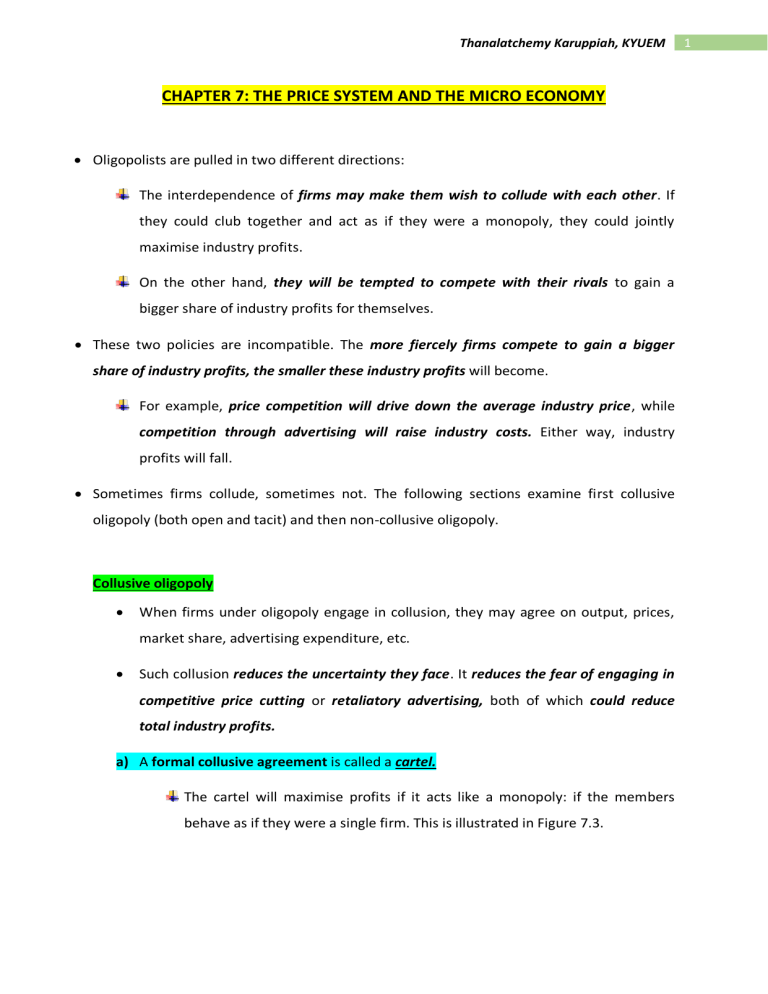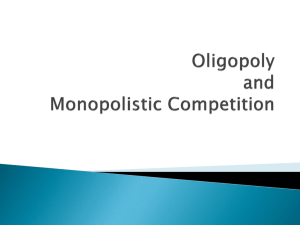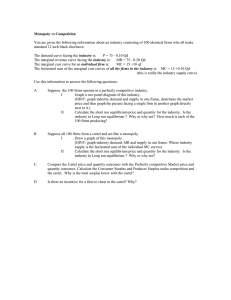
Thanalatchemy Karuppiah, KYUEM CHAPTER 7: THE PRICE SYSTEM AND THE MICRO ECONOMY • Oligopolists are pulled in two different directions: The interdependence of firms may make them wish to collude with each other. If they could club together and act as if they were a monopoly, they could jointly maximise industry profits. On the other hand, they will be tempted to compete with their rivals to gain a bigger share of industry profits for themselves. • These two policies are incompatible. The more fiercely firms compete to gain a bigger share of industry profits, the smaller these industry profits will become. For example, price competition will drive down the average industry price, while competition through advertising will raise industry costs. Either way, industry profits will fall. • Sometimes firms collude, sometimes not. The following sections examine first collusive oligopoly (both open and tacit) and then non-collusive oligopoly. Collusive oligopoly • When firms under oligopoly engage in collusion, they may agree on output, prices, market share, advertising expenditure, etc. • Such collusion reduces the uncertainty they face. It reduces the fear of engaging in competitive price cutting or retaliatory advertising, both of which could reduce total industry profits. a) A formal collusive agreement is called a cartel. The cartel will maximise profits if it acts like a monopoly: if the members behave as if they were a single firm. This is illustrated in Figure 7.3. 1 Thanalatchemy Karuppiah, KYUEM • The total market demand curve is shown with the corresponding market MR curve. • The cartel’s MC curve is the horizontal sum of the MC curves of its members (since we are adding the output of each of the cartel members at each level of marginal cost). • Profits are maximised at Q1 where MC = MR. The cartel must therefore set a price of P1 (at which Q1 will be demanded). • Problem with Cartel: i. higher prices and less output for consumers ii. overall profit is maximised at this price, individual firms have different cost structures and so not all firms will be maximising their own profits, and this can cause constant tension within the cartel. • So, collusion is generally banned by governments and is against the law in most countries. • If a country’s anti- trust authority finds that firms have engaged in anticompetitive behaviour such as price fixing agreements, then the firms will be penalized with fines or other punishments. 2 Thanalatchemy Karuppiah, KYUEM • Formal collusion between governments may be permitted. The prime example is OPEC (the Organisation for Petroleum Exporting Countries), which sets production quotas and prices for the world oil markets. OPEC is probably the best known of all cartels. It was set up in 1960 by the five major oilexporting countries: Saudi Arabia, Iran, Iraq, Kuwait and Venezuela. It has 12 members, including Nigeria, Angola, Libya and Ecuador. Its stated objectives were as follows: • The co-ordination and unification of the petroleum policies of member countries. • The organisation of means to ensure the stabilisation of prices, eliminating harmful and unnecessary fluctuations. • There are a number of conditions necessary for a cartel to operate successfully. These include: • i. a limited number of firms in the industry, all of whom are members similar cost structures for all firms ii. high barriers to entry to prevent new firms entering the industry iii. all firms obey the rules of the cartel iv. a stable market v. the firms produce very similar or identical products which will make agreements on price easier to establish. Is there any problem here for the cartel in fixing the price? Alternatively, the cartel members may somehow agree to divide the market between them. Each member would be given a quota. The sum of all the quotas must add up to Q1. If the quotas exceeded Q1, either there would be output unsold if price remained fixed at P1, or the price would fall. 3 Thanalatchemy Karuppiah, KYUEM • But if quotas are to be set by the cartel, how will it decide the level of each individual member’s quota? The most likely method is for the cartel to divide the market between the members according to their current market share. This is the solution most likely to be accepted as ‘fair’. • Where open collusion is illegal, however, firms may simply break the law, or get round it. • Alternatively, firms may stay within the law, but still tacitly collude by watching each other’s prices and keeping theirs similar. • Firms may tacitly ‘agree’ to avoid price wars or aggressive advertising campaigns. b) Tacit collusion: price leadership (Informal collusion) • Where oligopolists take care not to engage in price cutting, excessive advertising or other forms of competition. There may be unwritten ‘rules’ of collusive behaviour such as price leadership. One form of tacit collusion is where firms keep to the price set by an established leader. • There are three common models. Models Explanation Dominant firm models • This normally involves firms following the lead of a firm which has a dominant position in the market in terms of its output and market share. • Other firms will be likely to keep to the agreement for fear that if they do not their existence could be threatened by an aggressive pricing strategy by the dominant firm. Saudi Arabia, for example, is a dominant player in OPEC. Barometric firm price leadership • This involves leadership by a firm that has consistently been seen to judge market conditions accurately over time and is, therefore, seen as a good "barometer” of market trends. 4 Thanalatchemy Karuppiah, KYUEM • The barometric firm is the firm that is either trend setter for the product The innovator of a new technological production technique • The barometric firm need not be the largest firm and it could change from time to time. Parallel pricing This involves firms in the industry making the same price changes at any given time. 5





